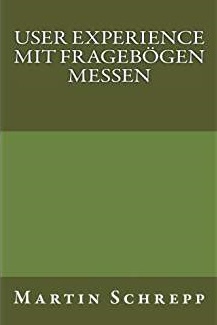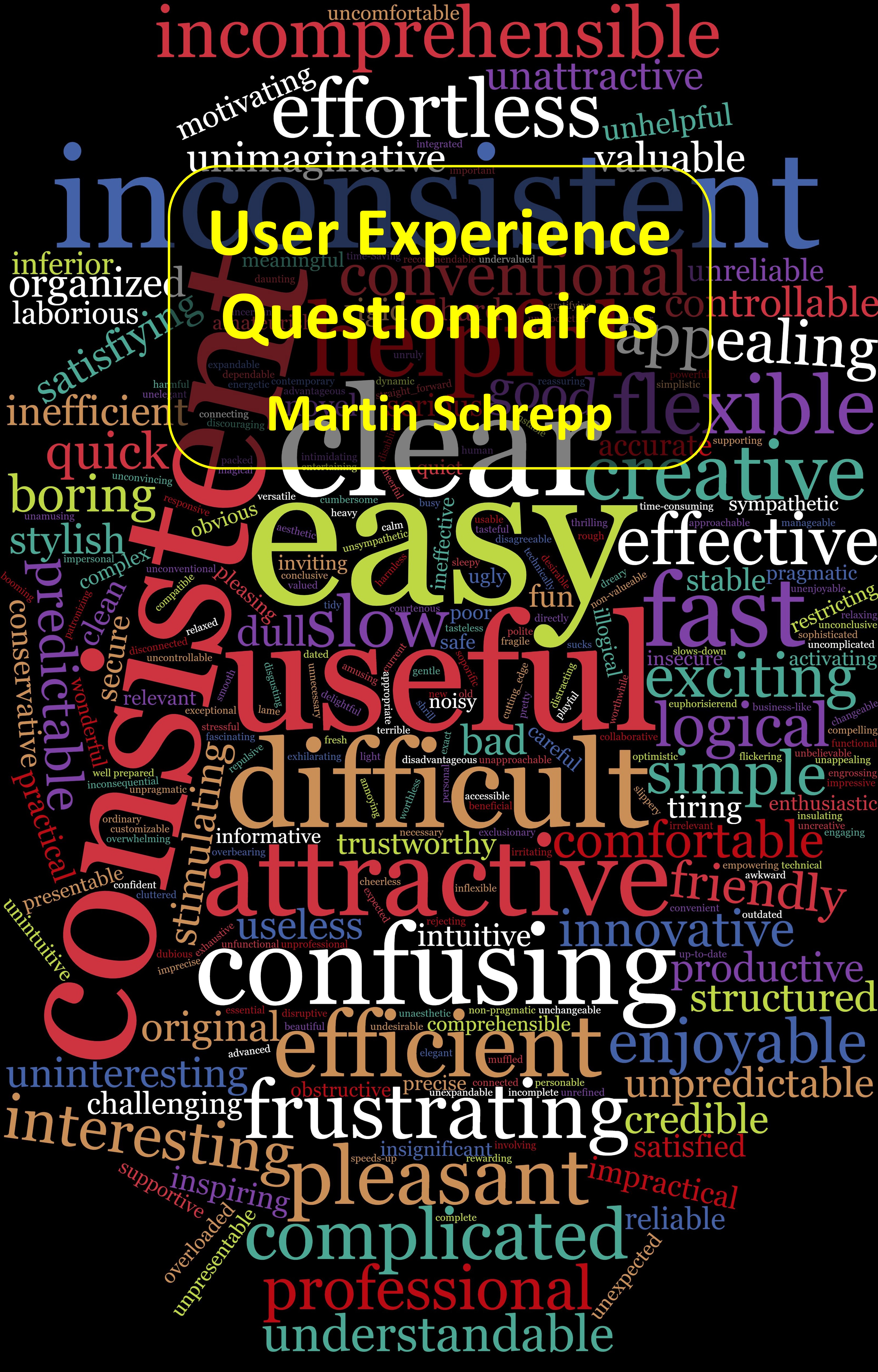A Modular Extension of the User Experience Questionnaire
The UEQ+ is a modular extension of the User Experience Questionnaire (UEQ). It consists of a list of UX scales that can be combined to build a questionnaire optimized for a concrete research question. Thus, the UEQ+ is a framework to build questionnaires optimized for special evaluation scenarios.
Available Scales
A more detailed explanation of the scales can be found in the UEQ+ handbook. Please check the handbook before you create your first questionnaire with the UEQ+.
| Scales not restricted to a special product type or scenario | |
| Efficiency | Impression that tasks can be finished without unnecessary effort. |
| Usefullness | Impression that using the product is beneficial. |
| Perspicuity | Impression that it is easy to learn how to use the product. |
| Adaptability | Impression that the product can be easily adapted to personal preferences or working styles. |
| Dependability | Impression to be in control of the interaction with the product. |
| Intuitive use | Impression that the product can be used immediately without any training or help. |
| Stimulation | Impression that it is interesting and fun to use the product. |
| Novelty | Impression that the product design or product idea is creative and original. |
| Trust | Impression of the users that their data are in safe hands and are not misused to harm them. |
| Attractiveness | Overall impression concerning the product. Do users like or dislike it? |
| For products with a graphical user interface | |
| Visual Aesthetics | Perception that the graphical user interface of the product looks beautiful and appealing? |
| Clarity | Perception that the user interface is well-structured and of low visual complexity. |
| Value | Impression that the product design looks professional and valuable. |
| Only for products that transport content or knowledge, for example info web sites | |
| Trustworthiness of Content | Impression that the information provided by the product is of good quality and reliable. |
| Quality of Content | Impression that the information provided by the product is actual and well-prepared. |
| For voice assistants, for example Siri or Alexa | |
| Response behavior | Impression that the voice assistant behaves respectful and trustworthy. |
| Response quality | Impression that the responses of a voice assistant cover the user’s information needs. |
| Comprehensibility | Impression that the voice assistant correctly understands the users instructions and questions using natural language. |
| For household appliances | |
| Haptics | Subjective feelings resulting from touching the product. |
| Acoustics | Subjective experience concerning the sounds or operating noise of the product. |
| For complex medical devices, for example MRI and CT scanners or imaging systems | |
| Result quality | Can goals and results be fully and accurately achieved by using the product? |
| Hardware security | Does the hardware bear risks, which might be hazardous to health? |
| Risk handling | Can users identify and handle risks and errors? |
| Scales that measure the impact of using or owning a product on social connections or status | |
| Identification | Impression that using or owning a product influences the social status |
| Social Interaction | Impression of the user that the product supports social activities or helps to build social contacts |
| Social Stimulation | Impression of the user regarding the anticipated social gains resulting from their interaction with a product |
| Social Acceptance | Impression of the user regarding how they are accepted and approved by others and themselves when using a product |
The scales Attractiveness, Perspicuity, Efficiency, Dependability, Stimulation and Novelty are part of the UEQ (see Laugwitz, Schrepp & Held, 2008). Haptics and Acoustics are described in Boos & Brau (2017), Trust in Hinderks (2016) and Clarity in Otten, Schrepp & Thomaschewski (2020). Developement of the scales Response Behavior, Response Quality, and Comprehensibility for voice assistants is described in Klein, Hinderks, Schrepp & Thomaschewski (2020). The developement process of the scales for complex medical devices (Result Quality, Hardware Security, Risk Handling) is described in Lindemann & Weber (2023) (concrete scale development is described in the master thesis of Hannah Bögler). Development and validation of the social scales is explained in Mortazavi, Doyon-Poulin, Imbeau & Robert (2023). The development of all other scales is described in Schrepp & Thomaschewski (2019).
News and recent activities
New presentations, papers or activities concerning the UEQ.
Conference Paper that shows how ChatGPT can be used to classify UX items.
Conference Paper that describes the validation of the UEQ+ trust scale.
Journal paper that describes the construction of four new UEQ+ scales to measure social aspects.
Conference Paper that describes the construction of the UEQ+ scales for complex medical devices.
Conference Paper that describes the impact of demographics and usage behavior on UX scores.
Conference Paper that describes the impact of item polarity on UEQ items and answers the question if we can compare scales scores from the original UEQ with scale scores in the corresponding UEQ+ scales.
Conference Paper that investigates the influence of usage context on the importance of UX aspects.
Important research papers describing the UEQ+
The development of the UEQ+ are described in a number of scientific papers.
- Schrepp, M. & Thomaschewski, J. (2019). Design and Validation of a Framework for the Creation of User Experience Questionnaires. International Journal of Interactive Multimedia and Artificial Intelligence, http://dx.doi.org/10.9781/ijimai.2019.06.006.
- Schrepp, M. (2021). Measuring User Experience with Modular Questionnaires. In International Conference on Advanced Computer Science and Information Systems (ICACSIS), Jakarta, Indonesia. DOI: 10.1109/ICACSIS53237.2021.9631321
- Schrepp, M., Sandkühler, H., & Thomaschewski, J. (2021). How to create short forms of UEQ+ based questionnaires?. Mensch und Computer 2021-Workshopband. DOI:10.18420/muc2021-mci-ws01-230. Show in the MCI Digital Library
- Schrepp, M., Kollmorgen, J., Meiners, A.L., Hinderks, A., Winter, D., Santoso, H.B., Thomaschewski, J. (2023). On the Importance of UX Quality Aspects for Different Product Categories, International Journal of Interactive Multimedia and Artificial Intelligence, http://dx.doi.org/10.9781/ijimai.2023.03.001.
- Santoso, H.B., Schrepp, M., Hasani, L.M., Fitriansyah, R., Setyanto, A. (2022). The use of User Experience Questionnaire Plus (UEQ+) for cross-cultural UX research: evaluating Zoom and Learn Quran Tajwid as online learning tools. Heliyon. DOI: 10.1016/j.heliyon.2022.e11748
- Meiners, A.L., Schrepp, M., Hinderks, A., Thomaschewski, J. (2023). A Benchmark for the UEQ+ Framework: Construction of a Simple Tool to Quickly Interpret UEQ+ KPIs. International Journal of Interactive Multimedia and Artificial Intelligence, (2023), http://dx.doi.org/10.9781/ijimai.2023.05.003
Available Languages
The UEQ+ is currently available in more than 20 languages. When new scales are added to the UEQ+ framework it will require some time until translations are available. Thus, these new scales may not be available in all translations. Only the German and English templates will always contain all scales.
German
Authors: Martin Schrepp, Jörg Thomaschewski
English
Authors: Martin Schrepp, Jörg Thomaschewski
Indonesian
Authors: H. B. Santoso, L. M. Hasani, R. Fitriansyah, A. Setyanto
Croatian
Authors: Mate Juric, Franjo Pehar, Nikolina Peša Pavlović
The following translations were provided by Henning Brau.
Portuguese
Spanish
Italian
Chinese
French
Finnish
Danish
Dutch
Norwegian
Turkish
Greek
Swedish
Polish
Bosnian
Hindi
Tamil
Russian
Hungarian
Hebrew
Bengali
Czech
Arabic
Marathi
Kannada
Download
All materials required to use the UEQ+ can be downloaded completely free of charge!
Try it
Try the UEQ+ from the perspective of a survey participant. We show three different scenarios to demonstrate how the questionnaire can be adapted to the needs of a project.
Some related methods
The User Experience Review (UER) is a modular approach to conduct an UX expert evaluation. It uses the scales of the UEQ+ as heuristics for the experts. Go to the web page of the method to find all relevant material required to conduct such a review.
The UEQ+ Team
Contact us in case of questions. We promise we won't bite!

Martin Schrepp
Dr. Martin Schrepp studied mathematics and psychology at University of Heidelberg. He received a diploma in mathematics 1990 and a Ph.D in psychology 1993. Since 1994 he works in various roles at SAP SE. His work experience includes writing technical documentation, software development and user interface design. Main research interests are the application of insights from cognitive science to the design of interactive products, accessibility and the development of methods for evaluation and data analysis.

Jörg Thomaschewski
Dr. Thomaschewski became Full Professor at the University of Applied Sciences Emden/ Leer (Germany) in September 2000. His research interests are human-computer interaction, and agile software engineering. Dr. Thomaschewski founded the research group “Agile Software Development and User Experience” at the University of Applied Sciences Emden/ Leer in 2009. He also has extensive experience in user experience training, user experience management, UX questionnaires, agile methods, IT analysis, e-learning, and consulting.
Contact:
Martin Schrepp
Schwetzinger Straße 86
68766 Hockenheim
Germany
We use icons from Font Awesome by Dave Gandy - http://fontawesome.io
Copyrights © 2019 All Rights Reserved by UEQ+ Team (Martin Schrepp and Jörg Thomaschewski)

